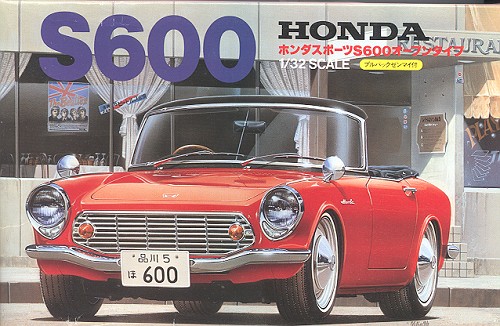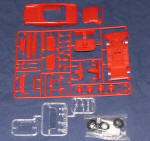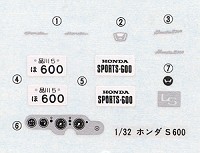
| KIT: | LS 1/32 Honda S 600 |
| KIT #: | 2104 |
| PRICE: | $9.98 from a vendor at the Atlanta Nationals |
| DECALS: | One option |
| REVIEWER: | Scott Van Aken |
| NOTES: | Motorized (sort of) |

| HISTORY |
Forty years
ago, Honda Motor Company was already well known for its high-performance
motorcycles that were capable of winning races like the death-defying Isle
of Man Tourist Trophy. Honda cars simply weren't available—yet. Soichiro
Honda, the company's founder, reportedly told some journalists, "Driving a
car is like sitting in the living room; driving a motorcycle is something
like riding a horse—it's driving and controlling something that is almost
alive." That said, Honda-san was very interested in expanding to automobile
production; but he'd have to wait until his company had attained the size
and the resources.
Honda's first serious effort was the S500, a
diminutive two-seat roadster with a 44-bhp, 531-cc four-cylinder,
motorcycle-inspired engine. S500's were available in Japan, Europe and the
UK, in 1964. Some 1,353 units were sold, but they were never officially
imported to the U.S. The following year, the S600 bowed in a race-tuned
606-cc version. It offered 70 bhp @ 10,000 rpm for the then-unbelievable
output of 115-bhp per liter. Denny Hulme drove one to a class win at the
Nurburgring in 1965, reportedly passing 33 cars on the first lap.
Production
S600s offered 57 bhp with a redlined tach that stretched from 9,500 to
11,000 rpm. Reportedly, the engine was comparatively mild until the 6,000
rpm level was reached, then it developed a calico-ripping snarl that
propelled the 1,640-lb S600 to 60 mph in 17 seconds, and would go on to 94
mph if you didn't mind the hornet-like buzz of its high-revving powerplant.
S600s were also not officially imported to the U.S. Still, a few found
their way here, usually imported by returning servicemen who'd paid about
$1,800 U.S. for them in Japan.
Slightly smaller than a Sprite, Spitfire or Lotus
Elan of its era, the S600, while not the quickest of the lot, would keep up
with any of them when driven in a spirited fashion. The Honda's
sophisticated four-cam, four-carburetor, water-cooled, hemi-headed alloy
engine was linked to a differential located just behind it, that in turn
ran a sealed roller chain drive setup. Four forward speeds, finned drum
brakes, and quick rack-and-pinion steering were all part of the impressive
specifications. Suspension was fully independent, with A-arms and torsion
bars in front, single trailing links and coil springs in the rear. Inside,
no-nonsense vinyl-covered bucket seats and a wood-rimmed wheel appealed to
sports car purists of the era.
"Road & Track" borrowed its road test S600 from a
reader in 1965, and enthused: "There's no burning of rubber, but the S600
scampers along to good effect and is great fun to drive...the steering and
handling of the Honda are excellent by any standards and, frankly, are
reminiscent of the much more expensive Lotus Elan than the cars in its own
price class." The high-revving four put out just 37.5 lb.-ft. of torque (at
5,500 rpm), so—just like today's S2000—drivers had to keep the revs way up
on the scale to get the full effect. The S600 was a true sports roadster.
Lollygaggers could choose from several low-revving, bigger-displacement
rivals. If you drove an S600, you were considered pretty serious.
Honda sold some 11,284 S600 convertibles and 1,800
coupes from 1964 until production ceased in 1966. The S600 was briefly
succeeded by the 791-cc S800, with more conventional shaft drive. Sadly,
they're all virtually impossible to find here today.
Article by Ken
Gross
| THE KIT |
 Molded
in red plastic, this neat little kit is very nicely detailed, especially
when one considers that it has to be at least 20 years old, as LS has been
out of business for at least that long. It has a relatively well detailed
interior with a decal for the instruments. No throttle, brake or clutch
pedal is included and the floor of the interior is the inside of the lower
chassis pan. There are interior door sections that fit onto the pan. You
have to realize that this kit is a curbside and much of the rear of the
body has to leave room for the gearbox/motor assembly.
Molded
in red plastic, this neat little kit is very nicely detailed, especially
when one considers that it has to be at least 20 years old, as LS has been
out of business for at least that long. It has a relatively well detailed
interior with a decal for the instruments. No throttle, brake or clutch
pedal is included and the floor of the interior is the inside of the lower
chassis pan. There are interior door sections that fit onto the pan. You
have to realize that this kit is a curbside and much of the rear of the
body has to leave room for the gearbox/motor assembly.

The nicely done clear bits seem to fit into place without too much fuss. These are provided for the windscreen, the rear window, headlights and bezels as well as the tail lights. Strong steel axles are given and the wheel/tire combination just slides onto it. You have the option of top up or down on this kit. No chrome is provided so this will all have to be painted on. Thanks to Alclad II and Bare Metal Foil, this shouldn't be a problem for most of us.
The instructions are entirely in Japanese, but with the clear drawings for the instruction, no problems should be found when building it. Paints seem to be in Gunze callouts, and the small decal sheet is well printed and doesn't appear to be yellowed
| CONCLUSIONS |
Not something sees every day, but it surely looks like a pretty fun kit to build and its diminutive size shouldn't take up a lot of room on the display shelf. Those who are into slot cars may want to consider this for one of their projects as there is plenty of room under the body for the standard rear motored chassis that are currently the rage.
Purchased by me for your viewing pleasure.
August 2005
| REFERENCES |
http://www.advancedautoparts.com
Purchased by me for you.
If you would like your product reviewed fairly and quickly by a site that has around 300,000 visitors a month, please contact me or see other details in the Note to Contributors.